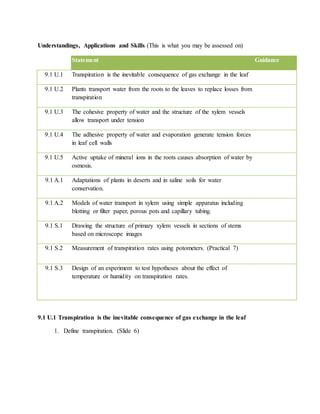
9.1 transport in the xylem of plants worksheet
- 1. Understandings, Applications and Skills (This is what you may be assessed on) Statement Guidance 9.1 U.1 Transpiration is the inevitable consequence of gas exchange in the leaf 9.1 U.2 Plants transport water from the roots to the leaves to replace losses from transpiration 9.1 U.3 The cohesive property of water and the structure of the xylem vessels allow transport under tension 9.1 U.4 The adhesive property of water and evaporation generate tension forces in leaf cell walls 9.1 U.5 Active uptake of mineral ions in the roots causes absorption of water by osmosis. 9.1 A.1 Adaptations of plants in deserts and in saline soils for water conservation. 9.1 A.2 Models of water transport in xylem using simple apparatus including blotting or filter paper, porous pots and capillary tubing. 9.1 S.1 Drawing the structure of primary xylem vessels in sections of stems based on microscope images 9.1 S.2 Measurement of transpiration rates using potometers. (Practical 7) 9.1 S.3 Design of an experiment to test hypotheses about the effect of temperature or humidity on transpiration rates. 9.1 U.1 Transpiration is the inevitable consequence of gas exchange in the leaf 1. Define transpiration. (Slide 6)
- 2. 2. Explain how the action of guard cells allows for the control of water loss. (Slide 8) 9.1 U.2 Plants transport water from the roots to the leaves to replace losses from transpiration 3. Annotate the diagram to explain how water is moving through the xylem tube from the roots to the leaf. (Slide 10) 9.1 U.3 The cohesive property of water and the structure of the xylem vessels allow transport under tension 4. State one property of water which allows transpiration pull to be generated. (Slide 11) 5. Water is strongly attracted to glass. How does this explain the shape of the meniscus? 6. Liquid mercury, unlike water, is repelled by glass. If you filled your cylinder with mercury instead of water, what would the surface of the mercury look like? Sketch your idea next to the graduated cylinder on the previous page. The Meniscus
- 3. 9.1 U. 4 The adhesive property of water and evaporation generate tension forces in leaf cell walls 7. Describe the journey water takes through the plant beginning at the roots. (Slide 14) 9.1 U.5 Active uptake of mineral ions in the roots causes absorption of water by osmosis. 8. Annotate the diagram below to explain the uptake of water by mineral exchange by adding K+ ‘s and H2O’s to the root hair: (Slide 15) 9. Explain why mineral ions need to be taken up by active transport in the roots. (Slide 15) 10. State the source of energy used in active transport at the root hairs. (Slide 15) 9.1 A.1 Adaptations of plants in deserts and in saline soils for water conservation 1. Define xerophyte. (Slide 18) 2. Describe the reproductive adaptations of xerophytes to minimize water loss. (Slide 19)
- 4. 3. Describe three physical adaptations of xerophytes to minimize water loss. (Slide 21) 4. Describe how CAM plant metabolism is an adaptation to preventing water loss. (Slide 24) 9.1 S.1 Drawing the structure of primary xylem vessels in sections of stems based on microscope images 11. Draw a cross section of the xylem tube below Cellulose wall
- 5. 9.1 A.2 Models of water transport in xylem using simple apparatus including blotting or filter paper, porous pots and capillary tubing. Fill 4 of the 7 (clear) 400ml beakers full with water. Add red food coloring to 2 beakers, yellow food coloring to 1 beakers and blue food coloring to another beaker. Place the beakers in a straight line alternating with the empty ones. (Red beaker, 1. empty beaker, yellow beaker, 2. empty beaker, blue beaker, 3. empty beaker, red beaker). Take the 6 flattened paper towel sheets and put them so that each end is in a different beaker (every beaker should have two ends of paper towel in it except the red ones on the ends), so the first paper towel sheet should have one end in the red beaker and the other end in the empty beaker next to it. The second paper towel sheet should have one end in that same empty beaker and another end in the yellow beaker right next to it. Wait 24 hours to get the full effect of capillary action record the colors below colors. Empty Beaker 1__________ Empty Beaker 2__________ Empty Beaker 3__________ 9.1 S.3 Designof an experiment to test hypotheses about the effect of temperature or humidity on transpiration rates. 12. Complete the table below explaining how a change in an abiotic factors affects the rate of transpiration in a plant (Slide 28): Affect Reason Temperature Light Wind Humidity
- 6. 13. Which leaf do you think would lose the most water? (Hint: Think about where most of the stomata are in a leaf) Explain why this would happen. 14. Which leaf do you think would lose the least water? Explain why this would happen. 15. Look at leaves B and C. Which of these two leaves do you think would lose the most water? Explain why this would happen. 9.1 S.2 Measurement of transpiration rates using potometers. (Practical 7) The rate of water loss from the plant through transpiration is found by measuring how far the water travels along the scale in a given time. Simon set up an experiment to compare the amount of water lost by the plant when it was light and when it was dark. These are his results.
- 7. 1. Plot the results for the light on a line graph. Then add the results for the dark onto the same graph. 2. What happens to the stomata of a leaf during the day? Why does this happen? How would this affect the rate of transpiration (would it increase or decrease)?
